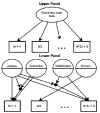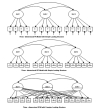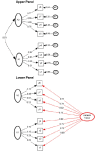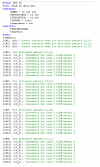Assessing Language Skills Using Diagnostic Classification Models: An Example Using a Language Instrument
- PMID: 37274518
- PMCID: PMC10233958
- DOI: 10.21500/20112084.5657
Assessing Language Skills Using Diagnostic Classification Models: An Example Using a Language Instrument
Abstract
The primary purpose of the present study is to inform and illustrate, using examples, the use of Diagnostic Classification Models (DCMs) for the assessment of skills and competencies in cognition and academic achievement. A secondary purpose is to compare and contrast traditional and contemporary psychometrics for the measurement of skills and competencies. DCMs are described along the lines of other psychometric models within the Confirmatory Factor Analysis tradition such as the bifactor model and the known mixture models that are utilized to classify individuals into subgroups. The inclusion of interaction terms and constraints along with its confirmatory nature enables DCMs to accurately assess the possession of skills and competencies. The above is illustrated using an empirical dataset from Saudi Arabia (n = 2642), in which language skills are evaluated on how they conform to known levels of competency based on the CEFR (Council of Europe, 2001) using the English Proficiency Test (EPT).
El propósito principal del presente estudio fue informar e ilustrar, mediante ejemplos, el uso de Modelos de Clasificación Diagnóstica (DCM) para la evaluación de habilidades y competencias en cognición y rendimiento académico. Un propósito secundario fue comparar y contrastar la psicometría tradicional y contemporánea para la medición de habilidades y competencias. Los DCM se describen siguiendo las líneas de otros modelos psicométricos dentro de la tradición del Análisis Factorial Confirmatorio, como el modelo bifactor y los conocidos modelos mixtos que se utilizan para clasificar a los individuos en subgrupos. La inclusión de términos y restricciones de interacción junto con su naturaleza confirmatoria permite a los DCM evaluar con precisión la posesión de habilidades y competencias. Lo anterior se ilustra utilizando un conjunto de datos empíricos de Arabia Saudita (n = 2642), que evalúan cómo las habilidades lingüísticas se ajustan a los niveles de competencia conocidos, basados en el MCER (Council of Europe, 2001).
Keywords: CEFR; Diagnostic Classification Models; bifactor models; cognitive Diagnostic Models; language.
Conflict of interest statement
Conflict of interests: The authors have declared that there is no conflict of interest.
Figures







References
-
- Alexander, G. E., Satalich, T. A., Shankle, W. R., & Batchelder, W. H. (2016). A cognitive psychometric model for the psychodiagnostic assessment of memory-related deficits. Psychological assessment, 28 (3), 279. 10.1037/pas0000163 - DOI - PubMed
- Alexander G. E., Satalich T. A., Shankle W. R., Batchelder W. H. A cognitive psychometric model for the psychodiagnostic assessment of memory-related deficits. Psychological assessment. 2016;28(3):279–279. doi: 10.1037/pas0000163. - DOI - PubMed
-
- Asparouhov, T., & Muthén, B. (2009). Exploratory structural equation modeling. Structural Equation Modeling, 16, 397-438. 10.1080/10705510903008204 - DOI
- Asparouhov T., Muthén B. Exploratory structural equation modeling. Structural Equation Modeling. 2009;16:397–438. doi: 10.1080/10705510903008204. - DOI
-
- Bonifay, W., & Cai, L. (2017). On the complexity of item response theory models. Multivariate behavioral research, 52 (4), 465-484. 10.1080/00273171.2017.1309262 - DOI - PubMed
- Bonifay W., Cai L. On the complexity of item response theory models. Multivariate behavioral research. 2017;52(4):465–484. doi: 10.1080/00273171.2017.1309262. - DOI - PubMed
-
- Bower, J., Runnels, J., Rutson-Griffiths, A., Schmidt, R., Cook, G., Lehde, L., & Kodate, A. (2017). Aligning a Japanese university’s English language curriculum and lesson plans to the CEFR-J. In F. O’Dwyer, M. Hunke, A. Imig, N. Nagai, N. Naganuma, & M. G. Schmidt (Eds.), Critical, Constructive Assessment of CEFR-informed Language Teaching in Japan and Beyond (pp. 176- 225). Cambridge University Press.
- Bower J., Runnels J., Rutson-Griffiths A., Schmidt R., Cook G., Lehde L., Kodate A. In: Critical, Constructive Assessment of CEFR-informed Language Teaching in Japan and Beyond. O’Dwyer F., Hunke M., Imig A., Nagai N., Naganuma N., Schmidt M. G., editors. Cambridge University Press; 2017. Aligning a Japanese university’s English language curriculum and lesson plans to the CEFR-J; pp. 176– 225.
LinkOut - more resources
Full Text Sources
